Bakrid Mubarak 2024: History and Significance of Eid-ul-Adha; Date of Celebration in India

Published By:
Last Updated:

Eid-ul-Adha is being celebrated today on June 17. (Image: Shutterstock)
Muslims prepare for celebrations by completing Wudhu and Fajr prayers, as well as paying special attention to their appearance.
Muslims commemorate Eid-ul-Adha, also known as the Feast of Sacrifice, for three days each year. It begins on the tenth day of the Islamic calendar’s last month, Dhu al-Hijjah. Given that Muslims follow the lunar calendar, it might happen at any time of year.
Eid-ul-Adha in India
This year, Eid-ul-Adha is being celebrated today on June 17.
History of Eid-ul-Adha
The celebration honours Prophet Ibrahim, also referred to as Abraham in Christianity and Judaism, for his willingness to offer his son Ismail (Isaac) as a sacrifice on Allah’s command.
According to the Quran, Ibrahim had a dream in which Allah ordered to sacrifice his son Ismail as a token of his submission to God.
In the story, Shaytaan (Satan), tries to trick Ibrahim and entice him not to carry out the deed, but Ibrahim squelches him.
But as soon as Ibrahim was all set to sacrifice Ismail, Allah intervened and summoned Angel Jibreel (Gabriel) along with a ram to serve in its place.
Eid-ul-Adha Significance And Celebrations
For Muslims, Eid-al-Adha is a particularly special day. Muslims believe that the command was a test from Allah, as the festival honours the prophet Ibrahim’s willingness to sacrifice his son when Allah told him to.
It is also significant given that it serves as a reminder to Muslims worldwide to rely on Allah in all matters and occurrences.
It is observed on the tenth day of Dhu al-Hijjah, the lunar month associated with the Hajj (pilgrimage). The Makkah pilgrimage is one of Islam’s five pillars.
Muslims prepare for celebrations by completing Wudhu and Fajr prayers, as well as paying special attention to their appearance.
Eid prayers are traditionally offered at large gatherings. After the prayer, there is a discourse, called a Khutba, that lasts for fifteen to twenty minutes.
After the sermon and prayers for Eid, the Qurbani sacrifice may start.
The flesh of the slaughtered animal is divided into three portions: one for the individual performing the sacrifice, one for friends and family and one for the underprivileged and needy.
Muslims then gather to commemorate the feast of the sacrifice, during which gifts and greetings are exchanged.
bakrid-mubarak-2024-history-and-significance-of-eid-ul-adha-date-of-celebration-in-india



